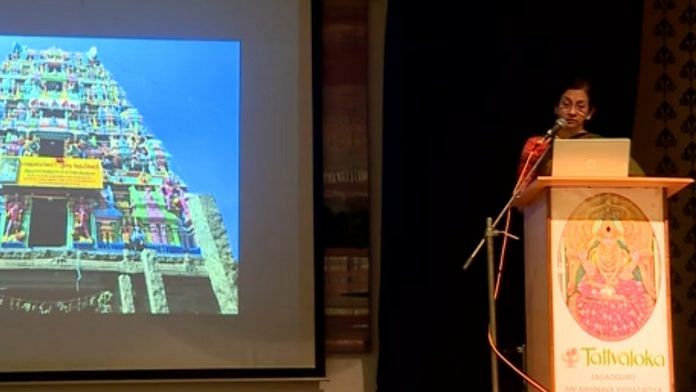Chennai: One of Rajiv Gandhi’s pet causes was strengthening the Panchayati Raj system in India. And by some accounts his inspiration came from an ancient and lesser-known temple in a Kancheepuram village about 90 km from Chennai.
Built during the Pallava dynasty’s rule, the Vaikunta Perumal Temple in Uthiramerur is not just a place of worship. Etched within its walls are inscriptions detailing the democratic practices followed in village administration during the reign of Parantaka I, a Chola dynasty emperor who ruled from 907 to 955 CE.
While the Vaikunta Perumal Temple may not be on the lists of most travellers or devotees, Tattvaloka, a Chennai-based organisation, is working to change that. It is spotlighting the more obscure ancient temples of Tamil Nadu through a series of lectures delivered by the eminent historian Chithra Madhavan. The series started in September 2023, with the latest of the five lectures so far taking place on 24 February 2024.
Tattvaloka, a unit of the Sringeri Sarada Peetham (one of the four mathas established by Sri Adi Sankara), is dedicated to “spreading the traditions and values enshrined in ancient scriptures” through books as well as events on topics related to spirituality and the Vedas.
Speaking before a rapt audience of around 50 people at an auditorium in Tattvaloka’s Chennai office, Mahadevan brought several forgotten temples and their fascinating stories to the forefront. During the one-hour lecture, she traversed through different centuries and dynasties, offering insights into sculptural details, inscriptions, and life in eras past.
“Not much is known about the lesser-known temples. The better-known ones are always highlighted,” she said. “It’s difficult to find information about the small temples and people don’t even know about them. I thought if I could do a lecture series, people would understand more.”
Madhavan added that the inscriptions in many of these temples are a window into ancient societies. For instance, she said, some inscriptions including at the Choleeswaram Temple show that women were giving donations. “We don’t know how much power the common women had,” she said. “But we know that they had enough property to give donations to the temple, and it’s recorded there.”
Also Read: Vijayanagara was the Indian Renaissance State. It contains memories of older empires
‘We see, but don’t look’
Madhavan’s lectures weave through temples from different eras, each revealing details and histories obscured by centuries of neglect.
The historian, known for her books on temple history, including History and Culture of Tamil Nadu (2005) and Vishnu Temples of South India (2007), said she doesn’t have any criteria while selecting the temples for the day. Instead, she prefers to “go with the flow” while exploring a particular region.
In the latest Tattvaloka lecture, her focus was on northern Tamil Nadu. “Each temple I speak about belongs to a different era. Some temples have developed over time with many dynasties contributing to them,” she said.
Showing pictures of the Vaikunta Perumal Temple, Madhavan drew attention to how it served as both a religious and political hub in the village. This is evident, she said, in the Sabha Mandapa, where the sabha or administrative meetings were held, sharing the space with the Vishnu sanctum.
Madhavan then delved into the intricate architectural and sculptural details of another ancient temple in the state’s northern region, the Sri Yoga Ramar temple in Tiruvannamalai district.
Legend has it that Lord Ram visited sage Shuka here after killing Ravana in Lanka without using any weapons. “In the main sanctum, Ram is seen with his left hand hanging down and right hand in chin mudra. Sita is next to him on the left side. Laxman is on the right side, holding a bow and arrow. Hanuman on the front, reading scriptures to which Ram is listening.” The carvings here, she told the audience, are “vintage Vijayanagara”.
Madhavan said she has no predetermined length for the series and hopes to continue for as long as possible. There’s certainly a lot of ground to cover. Tamil Nadu is reportedly home to over 79,000 temples, more than any other state, of which 46,155 are under the control of the Hindu Religious & Charitable Endowments Department (HR&CE).
“I have been to a lot of these temples. But we just walk through them and don’t pay attention. We just see, we don’t look,” said Bama, a 45-year-old technical writer from Chennai after attending the session. “It’s fascinating to know the details. How everything has a thought and how we can correlate everything. It’s amazing to know how life was then.”
Also Read: Who should run Hindu temples? Tamil Nadu is the epicentre in new tug-of-war
(Edited by Asavari Singh)



